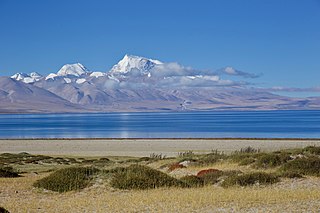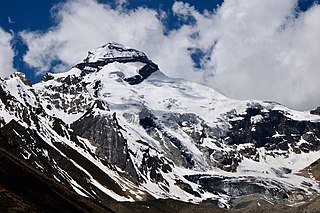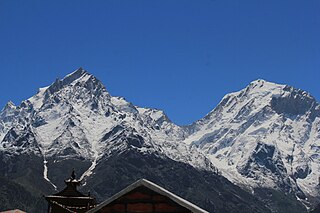
Licchavi was a kingdom which existed in the Kathmandu Valley, Nepal from approximately 400 to 750 CE. The Licchavi clan originated from Vaishali, and conquered Kathmandu Valley. The Licchavis were ruled by a maharaja, aided by a prime minister and other royal officials, but in practice local communities were controlled by caste councils.

Mount Kailash, is a mountain in the Ngari Prefecture, Tibet Autonomous Region of China. It has an altitude of 6,714 m (22,028 ft). It lies in the Kailash Range of the Transhimalaya, in the western part of the Tibetan Plateau. Mount Kailash is less than 100 km north of the western trijunction of the borders of China, India, and Nepal.

Nandi, also known as Nandikeshvara or Nandideva, is the bull vahana (mount) of the Hindu god Shiva. He is also the guardian deity of Kailash, the abode of Shiva. Almost all Shiva temples display stone-images of a seated Nandi, generally facing the main shrine.

Gurung, also known as Tamu Kyi or Tamu Bhāṣā, is a Sino-Tibetan language spoken by the Gurung people of Nepal. The total number of all Gurung speakers in Nepal was 227,918 in 1991 and 325,622 in 2011.

Ngari Prefecture or Ali Prefecture is a prefecture of China's Tibet Autonomous Region covering Western Tibet, whose traditional name is Ngari Khorsum. Its administrative centre and largest settlement is the town of Shiquanhe. It is one of the least densely populated areas in the world, with 0.3 people per kilometer.
Sin La is a high Himalayan mountain pass located in the eastern Kumaon in Pithoragarh District of Uttarakhand state in India.

The Ladakh Range is a mountain range in central Ladakh in India with its northern tip extending into Baltistan in Pakistan. It lies between the Indus and Shyok river valleys, stretching to 230 miles (370 km). Leh, the capital city of Ladakh, is on the foot of Ladakh Range in the Indus river valley.

The Digital Himalaya project was established in December 2000 by Mark Turin, Alan Macfarlane, Sara Shneiderman, and Sarah Harrison. The project's principal goal is to collect and preserve historical multimedia materials relating to the Himalaya, such as photographs, recordings, and journals, and make those resources available over the internet and offline, on external storage media. The project team have digitized older ethnographic collections and data sets that were deteriorating in their analogue formats, so as to protect them from deterioration and make them available and accessible to originating communities in the Himalayan region and a global community of scholars.

The orange-bellied Himalayan squirrel is a species of rodent in the family Sciuridae. It is found in Bangladesh, China, India, Myanmar, Nepal and Bhutan.

Raute are a nomadic traveling ethnic group officially recognized by the Government of Nepal. They are known for subsistence hunting of langur and macaque monkeys. They gather wild forest tubers, fruits, and greens on a regular basis. To obtain grain (rice), iron, cloth, and jewelry, they carve wooden bowls and boxes to trade for goods from local farmers. They do not sell other forest products, bushmeat, or forest medicinal plants. Raute do not share their language, hunting strategies and worship practices to the villagers to maintain their cultural purity. These days, they are accepting gifts and allowances from the government and non-government organizations in regular basis.
Vayu (वायु), Wayu or Hayu (हायु) is a Sino-Tibetan language spoken in Nepal by about 1740 people in Bagmati Province. Dialects include Pali gau Mudajor Sukajor Ramechhap Sindhuli and Marin Khola.
Charles Albert Edward Ramble is an anthropologist and former University Lecturer in Tibetan and Himalayan Studies at the Oriental Institute, Oxford University. Since 2009 he has been Professor and Directeur d'études at the Ecole pratique des hautes études, Paris. Between 2006 and 2013 he was elected president of the International Association for Tibetan Studies (IATS) and convened the 10th seminar of IATS at Oxford in 2003.

Limi Valley is a high-altitude valley that forms the northernmost part of the Humla District of north-western Nepal. To its north, the Limi valley borders the Purang County of Tibet, China.

Nicholas Gervase Rhodes was a British numismatist who specialised in the coinages of Asia, particularly those of Himalayan kingdoms and pre-Communist Tibet.
Thakali is a Sino-Tibetan language of Nepal spoken by the Thakali people, mainly in the Myagdi and Mustang Districts. Its dialects have limited mutual intelligibility.

Kumaon Kingdom was an independent Himalayan kingdom in Kumaon, a region located in the eastern part of the present-day Uttarakhand state of India. It was established around 7th century and remained an independent and sovereign kingdom until 1791.

Adi Kailash, also known as Shiva Kailash, Chota Kailash, Baba Kailash or Jonglingkong Peak, is a mountain located in the Himalayan mountain range in the Pithoragarh district of Uttarakhand, India. Adi Kailash & Limpiyadhura Pass are both located northwest of Gunji. The Lipulekh Pass, Old Lipulekh Peak & Om Parvat are located northeast of Gunji. Adi Kailash base camp, near the Hindu Shiva temple on the banks of sacred Jolingkong Lake, is located 17 km northwest of Kuthi (Kuti) village in Kuthi Yankti Valley. The Adi Kailash Yatra Circuit route-1 via Gunji, the eastern-southeastern route, is reached by the Pithoragagh-Lipulekh Pass Highway (PLPH) and its Gunji-Lampiya Dhura Pass Road (GLDPR) paved motorable spur via Kuthi Yankti Valley from Gunji to Adi Kailash. The Adi Kailash Yatra Circuit route-2 via Darma Valley, the western-southwestern route, begins by going up the Darma Valley and then crossing the Sin La pass south of Brahma Parvat to go to Kuthi Yankti Valley to Jolingkong Lake Base Camp. Many travellers who take the route-2, after the Adi Kailash darshan chose to traverse the route-1 in reverse direction till Gunji where they can join the Om Parvat & Mount Kailash-Lake Manasarovar Tibetan pilgrimage route along the Sharda River. Kailash-Mansarovar, Adi Kailash and Om Parvat are sacred to Hindus.

Sri Kailash is a mountain in Uttarakhand, India, the 47th highest located entirely within India. Nanda Devi, is the highest mountain in this category. Sri Kailash 204th highest peak in the world. The summit is 6932 meter or 22744 feet. It is the fourth highest mountain in the Gangotri region. The three above peaks in this region are Chaukhamba (7134m), Satopanth (7075m), Kedarnath (6940m). It is situated at the head of The Raktvarn Glacier.

Jorkanden is a 6,473-metre Himalayan peak in the Indian state of Himachal Pradesh. It is the highest peak in the Kinner Kailash range of the Greater Himalayas. An expedition team of the Indo-Tibetan Border Police first climbed the peak on 26 May, 1974. The peak is often confused with the Kinnaur Kailash peak (6,050m), which can be distinguished through its distinctly pointed 'pillar' on top, which is worshipped as a shivling, abode of the Indian god Shiva.
The Rang community are a Tibeto-Burman ethnic group dwelling historically in the upper parts of the Johar, Darma, and Mahakali valleys in India and Nepal. Some of them live in the Chameylia valley of Nepal. In Nepal and in the Johar valley of India, they are also known as the Shauka; sometimes, the Rungbas of the Mahakali and Darma valleys also prefer being called 'Shauka'.














